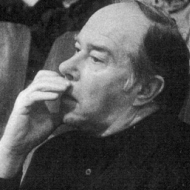Pavel Blatny hails from a musical family (his father, composer Josef Blatny studied with Leos Janacek). Having graduated from the Brno University (Musicology) and Conservatory, where he studied piano, conducting and composition, he started to study composition with Pavel Borkovec. The studies accented Blatny's inclination to neoclassicism which prefigured his first compositional period. It is characterized by Blatny's admiration for Stravinsky, Prokofiev and Martinu; he absorbed their artistic legacy and remelted it into an individual expression, featuring, among other things, independent application of two differing sound layers, which alternate in the course of the composition as two interlocutors (it is also denoted "the dialogue principle").
At the end of the '50s the neoclassical period was replaced by composer's interest in contemporary compositional techniques. Pavel Blatny was one of the first Czech explorers in twelve-tone system composition, but he was also one of the first who realized its limits and shortcomings. His individual way of composition arose from the effort to relax the rigor of dodecaphonic combustion and it is characterized by the aspiration to achieve a synthesis of the rational composition system and the spontaneity of direct musical expression, a synthesis of classical music and jazz, often described as "the third stream". Of all his compositions of this character, Concerto for Jazz Orchestra and 0:10:30 for symphony orchestra are especially notable. Thanks to that creative concept, Pavel Blatny's name gained quick popularity at home and abroad. He appeared in eighth place in the American jazz critics' charts for Down Beat magazine in 1966, in 1967 in fifth place, although he has never been a jazz musician per se.
In his third stream works Pavel Blatny was above all seeking a way to the listener. As in the course of the '60s it was becoming ever more apparent that compositions respecting the tonal feeling are most comprehensible to listeners, Blatny returned to tonality (for the first time in the composition called D-E-F-G-A-H-C in 1967). His third stream works underwent a specific development; while at the beginning of the '60s we could characterize it as an amalgamation of approaches used then by New Music and jazz, at the end of the '60s and in the '70s we must speak of a synthesis of jazz and neoclassical or neorenaissance elements.
At the beginning of the '80s Blatny's composition style developped from the third stream to classical genres, tonality, trim form, deliberately archaizing and simplified expression. This period began with The Willow, a cantata setting of K. J. Erben's popular poem which was awarded in 1981 the Czech Composers and Concert Artists' Union Prize, then followed the symphonic movement Bells and another two Erbenian cantatas Christmas Eve and The Noonday Witch. Importation and comprehensibility of contemporary music has been Pavel Blatny's aim in his creative endeavor so far. Spontaneous response to his extensive works (more than 500 compositions) that widespread and encompasses almost all kinds of music is a testimony to the success of his endeavor.
The synthesis of New music, jazz from the sixties, and the rock innovations by his son Marek (Confrontation, Play, Meditation) is characteristic for Pavel Blatny's more recent works which he wrote in the 1990s and in the first decade of the 21th century. Some of his late works are also inspired by his own earlier compositions (Erbeniade), and even by the works of his father Josef Blatny (Luhačovice Melancholy and others). Above all it is the method of polystylism which triumphs in his late works, e.g. Antivariation on the timbre of Antonin Dvořák, lately An Old Chant.
Awards
- Czech Composers' Association Prize (for The Willow, 1981)
- Leos Janacek Prize (for Christmas Eve, 1984),
- Anfiteatro D'argento - AVELLA (Neapol, Italy 1989)
- City Brno Award 2000

